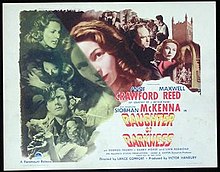| Daughter of Darkness | |
|---|---|
 | |
| Directed by | Lance Comfort |
| Written by | Max Catto |
| Based on | play "They Walk Alone" by Max Catto |
| Produced by | Victor Hanbury |
| Starring | |
| Cinematography | Stanley Pavey |
| Edited by | Lito Carruthers |
| Music by | Clifton Parker |
Production companies | Victor Hanbury Productions (in association with) (as
Kenilworth) Alliance Productions Ltd. |
| Distributed by | Paramount British Pictures (UK) |
Release dates | 23 January 1948 (London) United Kingdom 27 March 1948 (USA) |
Running time | 91 min |
| Country | United Kingdom |
| Language | English |
| Budget | £200,000 [1] |
Daughter of Darkness is a 1948 British film, with macabre overtones, directed by Lance Comfort and starring Anne Crawford, Maxwell Reed and – in the central role – Siobhán McKenna. Released in January 1948, it was based on a then ten-year-old play by Max Catto called They Walk Alone. [2] An expensive film for its day, it was shot at Riverside Studios, Hammersmith, London, (known at that time as Alliance Studios) and on location. [3] [4] McKenna was offered a Hollywood contract following her memorable performance, but heeded the counsel of Laurence Olivier to remain in theatre work. [5]
Plot
In the small Irish town of Ballyconnen, Emmy Baudine (Siobhán McKenna) is a beautiful but disturbed young woman who works for the local priest. When the fair comes to town, she encounters Dan (Maxwell Reed), a handsome young boxer – and lays his face open with her fingernails when he attempts to seduce her. Urged by the village women's jealousy and forebodings, Father Corcoran (Liam Redmond), reluctantly sends Emmy to friends, farming family, in Yorkshire, and Emmy endeavours to suppress the strange feelings of fascination and revulsion that she experiences in the presence of the opposite sex. But the fair's seeping, relentless prowl for profit, has already left Ireland, and is trundling its poisoned way through the arteries of Britain, seemingly knowing where its next victims live. Their next meeting cannot be resisted; nor can the allure of Emmy Baudine: to wherever she moves. [3]
Cast
- Anne Crawford as Bess Stanforth
- Maxwell Reed as Dan
- Siobhán McKenna as Emmy Baudine
- George Thorpe as Tallent
- Barry Morse as Robert Stanforth
- Liam Redmond as Father Cocoran
- Cyril Smith as Joe
- Honor Blackman as Julie Tallent
- Denis Gordon as Saul Trevethick
- Grant Tyler as Larry Tallent
- Norman Shelley as Smithers
- George Merritt as Constable
- Iris Vandeleur as Mrs. Smithers
- Ann Clery as Miss Foley
- Arthur Hambling as Jacob
- David Greene as David Price
Critical reception
The Radio Times wrote, "an opportunity to see McKenna, one of the most compelling of Irish stage actresses, portraying a maniac with full-blooded commitment." [6]
TV Guide noted, "strong stuff for 1948." [7]
In his Guide to British Cinema, Geoff Mayer writes, "Daughter of Darkness, with a budget of two hundred thousand pounds and three weeks of location shooting in Cornwall, was not a financial success and represented a setback to Comfort's career, which saw him relegated to low-budget films in the 1950s and 1960s. Yet the film's mixture of gothic and horror establishes it as one of the most startling British films of the 1940s. " [8]
References
- ^ McFarlane, Brian (1999). Lance Comfort. p. 82.
- ^ "Daughter of Darkness". BFI. Archived from the original on 14 January 2009.
- ^ a b "D". Irish Movie Madness.
- ^ "Twistedwing: CLASSIC HORROR: DAUGHTER OF DARKNESS (1948)".
- ^ "Guide To T20 – Siobhàn McKenna Papers". Archived from the original on 3 September 2014. Retrieved 30 August 2014.
- ^ Robin Karney. "Daughter of Darkness". RadioTimes.
- ^ "Daughter Of Darkness". TV Guide. Archived from the original on 7 November 2014. Retrieved 30 August 2014.
- ^ Mayer, Geoff (2003). Guide to British Cinema. ISBN 9780313303074.